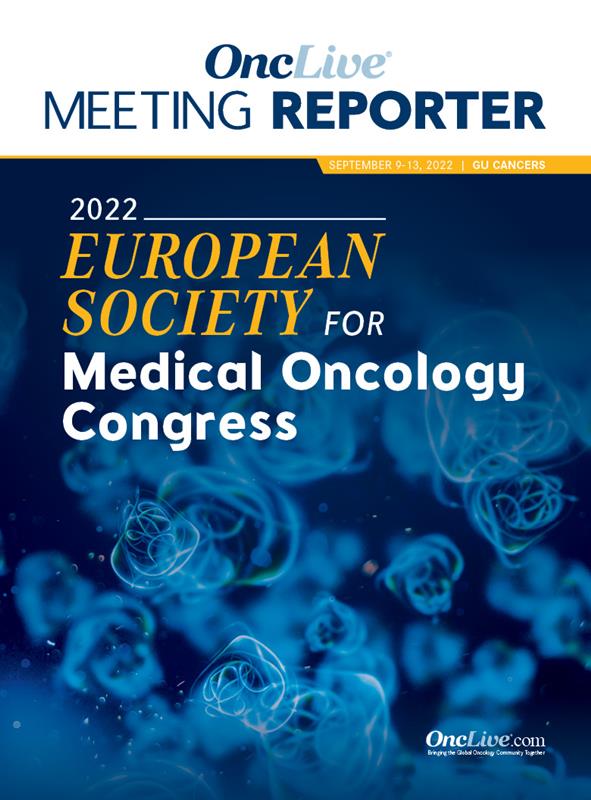Publication
Article
Supplements and Featured Publications
Frontline Immunotherapy Combos Linked With Higher CR Rates Than Anti-VEGF Therapy in mRCC
Author(s):
Immunotherapy-based combinations elicited higher complete response rates compared with VEGF-targeted therapy when used as first-line treatment in patients with metastatic renal cell carcinoma.

Immunotherapy-based combinations elicited higher complete response (CR) rates compared with VEGF-targeted therapy when used as first-line treatment in patients with metastatic renal cell carcinoma (mRCC), according to findings from an observational study presented at the 2022 ESMO Congress.
Data showed that patients who received immunotherapy-based combinations in the first line (n = 1126) achieved a CR rate of 4.6% vs 3.0% in those who received VEGF-targeted therapy (n = 7557), after adjustment for International Metastatic RCC Database Consortium (IMDC) risk (odds ratio, 1.56; 95% CI, 1.11-2.17; P = .009). Notably, real-world CR rates were not as high as those observed in clinical trials.
“Immuno-oncology–based combinations achieved CR in patients with traditional adverse clinicopathological features, [including] non–clear cell histology, sarcomatoid dedifferentiation, and multiple sites of metastases,” Kosuke Takemura, MD, PhD, MPH, of Tom Baker Cancer Centre at the University of Calgary, and colleagues, wrote in a poster presentation of the data.
Immunotherapy-based combinations have produced higher CR rates than VEGF-targeted therapy in multiple clinical trials. With the retrospective study, investigators aimed to characterize patients with mRCC who achieved a CR to first-line therapeutic options.
Investigators utilized the IMDC database to identify patients evaluable for response who were treated with either a frontline immunotherapy-based combination or VEGF-targeted therapy with sunitinib (Sutent) or pazopanib (Votrient) between 2005 and 2021. Best overall response was examined by investigators in accordance with RECIST v1.1 criteria. Patients received a frontline immunotherapy-based combination, consisting of 2 immunotherapy agents or 1 immunotherapy agent plus an anti-VEGF therapy, or VEGF-targeted monotherapy.
CR rates served as the primary outcome of the study. Secondary outcomes included baseline characteristics of those patients who experienced a CR vs those who did not achieve a CR, as well as overall survival (OS).
Regarding baseline characteristics, the absence of bone metastasis and favorable or intermediate IMDC risk were significantly linked with CR in both cohorts of patients. In patients in the immunotherapy cohort, 17.3% of complete responders had bone metastases compared with 33.7% of non–complete responders (P = .015). In the VEGF cohort, 11.9% of complete responders had bone metastases vs 32.6% of non–complete responders (P < .001).
In the immunotherapy cohort, the rates of complete responders with favorable-, intermediate-, and poor-risk disease were 26.7%, 62.2%, and 11.1%, respectively; among non–complete responders in this cohort, these rates were 16.1%, 56.8%, and 27.0%, respectively.
Among patients in the VEGF cohort, 21.7% of complete responders had favorable-risk disease, 65.8% had intermediate-risk disease, and 12.5% had poor-risk disease; those rates were 18.9%, 55.9%, and 25.3%, respectively, among non–complete responders in this cohort.
“Among those who experienced CR, non–clear cell histology, sarcomatoid dedifferentiation, and multiple sites of metastases were more frequently observed in the immunotherapy-based cohort,” the study authors wrote.
CR was an indicator of favorable OS, irrespective of the first-line therapy received, the authors concluded.
Reference
- Takemura K, Navani V, Erns MS, et al. Characterization of patients with metastatic renal cell carcinoma achieving complete response to first-line therapies: Results from the international metastatic renal cell carcinoma database consortium (IMDC). Ann Oncol. 2022;33(suppl 7):S660-S680. doi:10.1016/annonc/annonc1072










